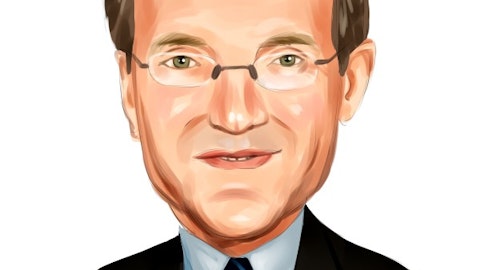Comerica Incorporated (NYSE:CMA) Q3 2023 Earnings Call Transcript October 20, 2023
Comerica Incorporated beats earnings expectations. Reported EPS is $1.84, expectations were $1.7.
Operator: Hello, and welcome to the Comerica Third Quarter 2023 Earnings Conference Call and Webcast. [Operator Instructions] As a reminder, this conference is being recorded. It’s now my pleasure to turn the call over to Kelly Gage, Director of Investor Relations. Please go ahead, Kelly.
Kelly Gage: Thanks, Kevin. Good morning, and welcome to Comerica’s third quarter 2023 earnings conference call. Participating on this call will be our President, Chairman and CEO, Curt Farmer; Chief Financial Officer, Jim Herzog; Chief Credit Officer, Melinda Chausse; and Chief Banking Officer, Peter Sefzik. During this presentation, we will be referring to slides which will provide additional details. The presentation slides and our press release are available on the SEC’s website, as well as in the Investor Relations section of our website, comerica.com. This conference call contains forward-looking statements. And in that regard, you should be mindful of the risks and uncertainties that can cause actual results to vary materially from expectations.

A finance executive tapping away on a digital tablet, demonstrating the company’s digital innovation. Editorial photo for a financial news article. 8k. –ar 16:9
Forward-looking statements speak only as of the date of this presentation, and we undertake no obligation to update any forward-looking statements. Please refer to the safe harbor statement in today’s earnings presentation on Slide 2, which is incorporated into this call, as well as our SEC filings for factors that can cause actual results to differ. Also, this conference call will reference non-GAAP measures. And in that regard, I direct you to the reconciliation of these measures in the earnings materials that are available on our website, comerica.com. With that, I’ll turn the call over to Curt Farmer.
Curt Farmer: Well, thank you, and good morning, everyone. Thank you for joining our call. Today, we reported third quarter net income of $251 million, or $1.84 per share — moderation per share, exceeding expectations. [indiscernible] optimization and moderation in customer demand drove the decline in average loans to $54 billion. Successful execution of our targeted deposit strategy grew customer balances, enabling us to repay $5 billion in maturing FHLB advances. Our continued focus on fee income produced another robust quarter, and credit quality remained very strong with modest net charge-offs, following three consecutive quarters of net recoveries. Complementing our compelling financial results, we advanced other strategic initiatives.
Small business remains a priority. And I’m excited to announce that we exceeded our $5 billion lending goal ahead of our three-year commitment. With our investments in talent, products and services for this important sector, we believe small business will become a growth engine over time. Achievements such as publishing our first financed emissions report, making community development investments and recognition for our volunteer program further underscore the value we place on supporting the communities we serve. Advancing our Ameriprise partnership and selective talent acquisition within wealth management, position us to achieve our noninterest income objectives while deepening customer relationships. We continue modernizing our approach to technology to better enable agile product enhancements as we leverage off-premise platforms to run over three quarters of our business applications.
Progress towards these initiatives allow us to balance the strength of our legacy for the future vision to sustainably support our customers as a trusted banking partner. Moving to a summary of our results on Slide 4. Average loans declined $1.4 billion, with the largest reduction resulting from our strategic exit of Mortgage Banker Finance. Success in winning new deposits and bringing back customer balances drove an increase in average deposits of $1.6 billion. Net interest income exceeded expectations for the quarter, even with the impact of competitive deposit pricing and loan trends. Credit quality remains very strong despite continued expected migration. Outperformance in noninterest income partially offset higher-than-expected expense pressures.
Finally, profitability and loan selectivity further enhanced our capital position as we generated an estimated CET1 ratio of 10.79%, above our 10% target. Despite the disruptive industry events earlier this year, we effectively managed our balance sheet to create abundant liquidity, enhanced returns over time, while taking care of our customers and exceeding the profitability expectations. Now, I will turn the call over to Jim, who’ll walk through the quarter in more detail.
Jim Herzog: Thanks, Curt, and good morning, everyone. Turning to Slide 5. Our strategic actions and shift to optimization caused average loans and commitments to decline. The exit of Mortgage Banker Finance is progressing as expected and contributed to almost half of the reduction in average balances. We still expect the exit to be substantially complete by year-end. Declines in equity fund services were largely concentrated in non-relationship customers, but we remain committed to this important business. Lower utilization within general middle market reduced balances, reflecting softening loan demand in this elevated rate environment. Ongoing funding of multi-family and industrial construction projects continue to drive higher commercial real estate utilization, but we saw an inflection in commitment growth as we strategically managed pipeline and origination volume.
The floating nature of our commercial loan portfolio benefited from rising rates as loan yields continued to climb to 6.34% in the third quarter. Slide 6 demonstrates our successful deposit generation. Average deposit balances increased 2.4%, exceeding expectations and HA trends as we added new deposits and won back customer balances that diversified earlier in the year. In fact, corporate banking and middle market California both closed the quarter in line with their early March balances after experiencing more concentrated diversification in Q1. As expected, noninterest-bearing deposits trended down at a decelerating rate with the lowest balance decline in the last four quarters. Considering that modest reduction, our deposit mix was more impacted by growth in the denominator, with success in winning interest-bearing deposits.
We continue to view our deposit mix as a competitive advantage, providing a more stable and cost-effective funding source than our peers. Industry efforts to enhance liquidity drove competition. And when combined with a higher rate environment, deposit costs increased to 290 basis points, resulting in a cumulative beta of 55%. In recent weeks, deposit betas have been moderating and we intend to remain nimble on our relationship pricing approach, so we are able to balance customer needs with profitability targets, while closely monitoring the market. With an even lower percentage of uninsured deposits, the operating nature of our accounts and an enviable customer base, we believe our strong deposit profile is now even more attractive. As shown in Slide 7, our effective liquidity strategy and strong deposit growth allowed us to absorb all of our contractual wholesale funding maturities this quarter.
We expect to continue to utilize excess cash to further reduce wholesale funding in the coming quarters. Our loan-to-deposit ratio continue to trend favorably, closing at 80% for the quarter. With significant liquidity capacity and very light remaining unsecured funding maturities, we have flexibility to manage funding needs and are better positioned to prioritize high-return growth in 2024. Period-end balances in our securities portfolio, on Slide 8, declined $1.1 billion, with paydowns, maturities and a $710 million negative mark-to-market adjustment. Although we have nominal treasury maturities remaining in 2023, larger scheduled maturities and anticipated securities repayments over the next two years are projected to benefit net interest income and AOCI.
Altogether, we project a 25% improvement in unrealized securities losses over the next two years. This estimated burn-off is sensitive to the dynamic rate environment and length in the quarter-end. However, since our portfolio is pledged to enhance our liquidity position, we do not anticipate any need to sell securities and, therefore, unrealized losses should not impact income. Overall, our security strategy remains unchanged as we stopped reinvesting over a year ago, and we maintain our entire portfolio as available for sale, providing full transparency and management flexibility. We will continue to closely monitor final regulatory rules to consider the impact on our security strategy as we consider the need for future compliance. Turning to Slide 9.
Net interest income decreased $20 million to $601 million, but outperformed expectations. We were encouraged by the lower pace of decline in net interest income as we move closer to what we believe may soon be an inflection point. Competitive deposit pricing and lower loan balances offset the benefits of loan yields and reduced wholesale funding balances. With the strategic management of our interest rate sensitivity, rates have phenomenally impacted income and we remained effectively asset neutral. As shown on Slide 10, successful execution of our interest rate strategy and the current composition of our balance sheet favorably position us with minimal negative exposure to a gradual 100 basis points or 50 basis points on average decline in interest rates.
By strategically managing our swap and securities portfolios, while considering balance sheet dynamics, we intend to maintain our insulated position over time. Credit quality remains very strong, as highlighted on Slide 11. Following three consecutive quarters of net recoveries, we observed modest net charge-offs of $6 million. As expected, credit migration continued with greater concentration in businesses with more relative exposure to elevated rates and inflationary pressures, including commercial real estate, leveraged loans, and technology and life sciences. While the economic forecast improved slightly from the prior quarter, the outlook remained uncertain, which when coupled with lower loan balances, which impacted loan mix, contributed to an increase in our allowance for credit losses to 1.38% of total loans.
Notably, non-accrual loans declined for the sixth consecutive quarter, and inflows to non-accruals of $14 million also declined. Consistent with our proven credit discipline, we continue to closely monitor our portfolio and expect further migration to remain manageable. On Slide 12, noninterest income of $295 million was our third highest quarter on record, following our second highest quarter in 2Q. Deferred compensation, which was fully offset in expenses, reduced $7 million, contributing to most of the noninterest income decline. Softer derivative activity more than offset increased loan syndication fees, pressuring capital markets revenue. Fiduciary income was negatively impacted by annual fees received in the prior quarter. Movement in the rate curve benefited risk management hedge income, but will vary in the future based on the rate environment and the position of our hedging portfolio.
Growth in noninterest income continues to enhance our overall revenue profile and capital efficiency over time. Expenses, on Slide 13, increased $20 million. Salaries and benefits were up $9 million and $8 million of that increase was in temporary labor due to staff augmentation, advancing technology and wealth management initiatives. Outside processing increased $7 million, driven by certain vendor terms that are sensitive to interest rates and our Trust Platform conversion. Other expenses benefited from large modernization credits from the sale of real estate, offset by increased litigation and regulatory-related expenses, consulting fees and operational losses. We believe we in the industry are in a period of calibration, as we balance the profitability and risk management impacts from the first quarter disruption, with strategic investments critical for future growth.
We remain committed to managing an efficient organization and are assessing opportunities to offset some of these pressures so that we may continue to deliver strong returns over time. Slide 14 highlights our solid capital position. Capital generation from profitability and lower loan balances drove our CET1 ratio further above our target to an estimated 10.79%. Our third quarter tangible common equity ratio of 4.62% includes a negative 502 basis point impact from AOCI. Higher rates increased unrealized losses in our securities and swap portfolios, driving a more negative impact than the prior quarter. Based on the September 30 forward curve, we anticipate approximately a 37% reduction in our unrealized losses by the end of 2025. Although the proposed capital changes do not apply to us based on our asset size, we favor a conservative approach to capital management and feel it is prudent to remain mindful of the regulations as they evolve.
Our outlook for 2023 is on Slide 15, and assumes no significant change in the economic environment. We project full year 2023 average loan growth of 7%, which would be our highest annual loan growth rate in a decade. The strategic exit of Mortgage Banker Finance and increased selectivity is expected to continue to impact fourth quarter balances. Our projected full year average deposit decline of 13% improved over prior expectations, with the success in winning new deposits and bringing back customer balances. With the exception of the impact from our Mortgage Banker Finance exit and utilizing excess cash to modestly reduce the maturing broker deposits, we expect deposits to remain relatively flat in the fourth quarter. Our outlook does not assume a significant benefit from seasonality, but if we did see a return to more normal fourth quarter seasonal patterns that may provide more upside than projected.
We still expect another record year of net interest income in 2023, growing 1% to 2% over last year’s record results. Competitive deposit pricing, continued deposit mix change, and a modest decline in loans are expected to drive a 5% to 6% reduction in fourth quarter net interest income. Although short-term rates are expected to remain high through year-end, our asset sensitivity position is designed to protect our profitability by minimizing the negative impact of rates when they decline. Credit quality remained very strong, and we expect continued migration to be manageable. We forecast full-year and fourth quarter annualized net charge offs to remain below our normal 20 basis point to 40 basis point range. Noninterest income has exceeded expectations for the first three quarters, and we project full year growth of 9% over 2022.
Benefits from non-customer income from FHLB dividends are expected to continue, but at declining rates, as we repay maturing advances. Risk management income is expected to eventually reduce over time with rates and our swap position. For the fourth quarter, noninterest income is expected to decline 3% to 4%, largely driven by a reduction in capital markets income considering market dynamics and increased selectivity. Noninterest expenses are expected to increase approximately 11% year-over-year, with 3% of that growth attributed to higher 2023 pension expense and almost 2% due to higher FDIC expense. Fourth quarter expenses are projected to increase 3%, as we observed pressures related to investments in technology and risk management in addition to third quarter modernization gains that are not expected to repeat.
While we are not offering 2024 guidance, we are mindful of the need to mitigate expense pressures as we recognize the new funding paradigm in the industry. These pressures are largely concentrated in the need for selective ongoing strategic investments, in addition to investments to further enhance risk management and regulatory compliance. We are in the process of evaluating cost reduction opportunities, with the objective of keeping 2024 costs only modestly higher than 2023. This assumes no change in pension expense, which will be determined largely by year-end rates and market performance. Prudent expense management remains a priority as we work to balance our expense base commensurate with our earnings power. Strong profitability is expected to further grow our capital position in excess of our 10% target.
Share repurchases remain paused, considering the ongoing volatility within unrealized AOCI losses and subject to further regulatory clarity. In all, it was a solid quarter of a strong deposits, liquidity, fee income and credit. We believe we are in great shape as we look to finish out the year and prepare for 2024. Now, I’ll turn the call back to Curt.
Curt Farmer: Thank you, Jim. Slide 16 summarizes our differentiated value proposition. As a leading bank for business, with strong wealth management and retail capabilities, our tenured colleagues deliver value-added industry expertise to our blue-chip customer base, while our highly regarded approach to credit has historically outperformed our peers. Complementing our commercial loan expertise, our relationship model is exemplified by a product set tailored to meet our customer needs, enhancing revenue and retention. Our deposit profile has long been a strength with a focus on commercial operating deposits and a consistent retail base. With new products already in the market and additional efforts underway to expand small business and payments, we expect this core funding source to be even more compelling.
Finally, we remain committed to running an efficient organization, and we’ll be taking steps to offset expense pressures while leveraging investments designed to enhance productivity and optimize resources. Before we open the line to questions, I just want to comment on what a remarkable quarter we think this was for our company. After the significant industry disruption this past spring, once again, our relationship-based model has proved resilient. We’re very proud to see a return to deposit growth, especially when the H8 data shows declines across the industry. Our liquidity is in great shape. We repaid significant FHLB advances, and our loan-to-deposit ratio puts us in a very favorable position. Credit remains strong, and fee income continued to perform at near-record levels.
During this disruptive time, we have taken care of our customers, we’ve borne back deposits, we’ve added new relationships, and still exceeded profitability expectations. As I shared on our prior calls, throughout our almost 175-year history, we have managed through a number of challenges, and I’m confident in our ability to navigate this environment. We remain focused on our core strategy, enhancing efficiency, managing risks, protecting returns and positioning for organic growth. With the uncertain economic landscape and being just under $86 billion in assets, I feel very good about Comerica’s position. We’re proud of our colleagues to the performance we delivered. We appreciate your time this morning. And now operator, we’d be happy to take some questions.
Operator: Certainly. [Operator Instructions] Our first question today is coming from Jon Arfstrom from RBC Capital Markets. Your line is now live.
See also 20 Most Geographically Diverse Countries In The World and Top 20 Brands Among Gen Z in the US by Mindshare.
Q&A Session
Follow Comerica Inc W (NYSE:CMA)
Follow Comerica Inc W (NYSE:CMA)
Jon Arfstrom: Thanks. Good morning, everyone.
Curt Farmer: Good morning.
Jon Arfstrom: Hey. Good morning. Curt, question for you just on one of the last comments you made about deposit growth. You mentioned that you’re adding and bringing back customer deposits. Can you talk about the extent of what you brought back, and why these clients are coming back, and kind of the extent of it and what’s left to bring back?
Peter Sefzik: Hey, Jon. This is Peter. So, yeah, the bringing back clients, I would say a lot of that has occurred probably in our middle market businesses. So, if you look back to pre-SEB, and Jim mentioned this, for example, middle market California, corporate banking, we’re back to pre-SEB levels in those businesses, but that’s true in a couple of other businesses as well. Environmental services has that sort of results, and middle market overall, I think has performed really well. A lot of our new deposit growth, I would say would be in middle market, small business, business banking. We’re really being aggressive on trying to attract granular deposits, small business deposits. We’re making a lot of investments there in people and product.
And so, that’s the success that we’ve had. I think as the year has gone on, our customer base and prospects have continued to have a lot of confidence in our name and our success. And while all the banks were challenged between March and April, I think we’ve proven to be pretty resilient through this.
Jon Arfstrom: How rate sensitive are those deposits? Or is this kind of, call it, relationship gathering?
Peter Sefzik: I think it’s a little bit of both. I think some of it is providing confidence overall that occurred early in the year. But certainly, you’re attracting some of it with interest-bearing rates that we’re being competitive on. And I think we talk a little bit about what we’re seeing on our deposit betas here today. But — so it’s a little bit of both. I think some of it’s product investment that we’ve made to make it easier for our customers to manage their liquidity. But we’re certainly doing what we need to do to be competitive with other banks on the interest rate environment.
Jon Arfstrom: Okay. Jim, one for you. You are kind of dancer on this in terms of you’re talking about betas moderating and we still have this down net interest income sequentially and down margin. But the way things sit today, if the Fed is done, what’s your best guess on NII inflection for the company?
Jim Herzog: Yeah. Thanks, Jon, and good morning. I do feel like the pathway on that inflection point is becoming a little bit more on the focus, even though there is still some degree of uncertainty. I would say right now, our base case is that we’ll probably hit a trough in Q1, but whether or not that’s the inflection point, and again, that is the base case, and more importantly, what that upward slope of the line will be from there, really depends on a lot of things, as you know. A lot of uncertainty out there, deposit betas, the Fed stays higher for longer, how do betas respond. And just as importantly, if rate cuts occur, how much is there in terms of a deposit pricing lag, monetary policy. Loan volume, we do anticipate growing at some point in ’24.
That’s certainly a variable loan pricing is out there. It’s a variable. We think that the new funding paradigm commands wider spreads or higher yield, but it remains to be seen if the market will accept that. So, a lot of variables out there, but I’ll just circle back and say at this point, we think the trough is likely to be Q1, then a little bit of a slope up from there.
Jon Arfstrom: Okay. All right. Thank you. I appreciate it.
Curt Farmer: Thanks, Jon.
Operator: Thank you. Next question is coming from Ebrahim Poonawala from Bank of America. Your line is now live.
Curt Farmer: Ebrahim, good morning.
Ebrahim Poonawala: Good morning. Maybe Jim, first for you, looking at the Slide 10 rate sensitivity, when we look at — so it looks like, obviously, you’ve not added any new swaps this year. When we look at the trajectory of the swaps and the outlook, is the jack from the swaps fully baked into as we look into the third quarter and fourth quarter outlook incrementally? Does it get worse or does it just level off if rates don’t change? And just give us a sense, do you expect any additional changes around balance sheet mix going into next year and whether or not you’re thinking about protecting eventually against rate cuts or not?
Jim Herzog: Yeah. Ebrahim, you were cutting out a little bit, but I think I got the gist of the question. We are relatively interest neutral is how I think of it right now. We do have some swaps that will mature over the next five quarters, but we also have a number of forward starters that are coming onto the books over the next five quarters also. And so, based on the amount of forward starters that are coming on, I think we have more forward starters coming on than maturing swaps, I don’t see a need to go out and acquire any more swaps. Now, we’ll continue to monitor how the balance sheet responds and noninterest-bearing deposits respond, which have an impact in that sensitivity equation. But for now, I feel really comfortable that we’re well prepared for a drop in rates should they occur.
Ebrahim Poonawala: And I guess maybe just a separate question on credit quality. Maybe if we can unpack the three areas that you called out on CRE leveraged loans and tech, like how do you expect the losses to evolve within those three buckets? And any impact on your sort of auto exposure when we think about the UAW strike? And if that gets prolonged, if we could see some negative migration or losses?
Melinda Chausse: Yeah, Ebrahim, thank you. This Melinda. I’ll just make some overarching comments around credit, just to reiterate what both Curt and Jim said. We’re really proud of the quarter. Credit continues to hold up really, really well. As you can see on Slide 11, we did have an increase in our criticized assets. We absolutely projected that we would continue to see normalization. That is exactly how it’s playing out. The majority of the increase in criticized this quarter came from that commercial real estate book. And as of right now, we do not really see a lot of lost content in that commercial real estate portfolio. Just as a reminder, we’re very heavily concentrated in construction financing with very strong borrowers and sponsors.
Very low loan to cost is really how we underwrite, and it’s predominantly multi-family and industrial. So, the industrial segment is holding up incredibly well. We don’t have any criticized assets in industrial. Multi-family is really where we’re seeing some of the migration. And that’s, again, expected just given what the right environment has done, just as well as a bit of oversupply in certain markets. So, there is some rent leveling out and starting to feel a little bit of rent concessions. We have no delinquencies, no past dues in this portfolio. Our sponsors are stepping up as we would’ve expected them to based on their historical performance, and they are covering shortfalls. So, I do not expect to see losses coming through the commercial real estate portfolio.





